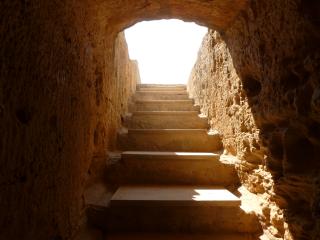Advertisement
Few Unitarian Universalists believe there was a physical, photographable resuscitation of Jesus’s corpse. Few believe that Jesus knowingly sacrificed his life to atone for the sins of humanity or that only by his sacrifice and our belief in him as our Lord and Savior can each of us, individually, be saved. There is also very little biblical evidence for those claims.
Unitarian Universalists primarily speak, if we use the term at all, of resurrection within our own lives, before our physical death. This type of resurrection, of course, includes the Apostles’ experience—perhaps by vision, or dream, or mystical experience, or otherwise altered state of consciousness—of Christ being present to them after his death and turning their lives around so they could be reborn to teach and preach and heal and challenge the status quo of their day.
The Rev. Carl Scovel explains in An Easter Faith that the resurrection comes with the recognition that any of our lives can always be transformed and begin again. The resurrection comes with the Christ within us breaking forth, as if from the tomb, inviting us to be reborn by enacting the Christ-self we had forgotten or never known. Innumerable resurrections have happened again and again. By experiencing the risen Christ in their lives, people have stopped drinking, changed jobs at great risk, and held their ground before dictators. And so much more. (See The Unitarian Universalist Christian Vol. 57, 2002: 32–35.)
The website of the Unitarian Universalist Association explains that although the Easter service is one of the most well-attended services of the year in our denomination, we do not take Jesus’s resurrection literally. We emphasize the metaphorical, and we talk about the ultimate triumph of life over death. We also speak of many different kinds of resurrection, including the rebirth of nature, the resurrection of hopes and dreams, and the renewal of dead relationships. In “What’s a UU Family To Do on Easter?” Michelle Richards acknowledges that a number of Unitarian Universalists have no problem celebrating Christmas, a holiday marking the birth of Jesus, but balk at one commemorating his resurrection, which they find contrary to their own beliefs. So most of us begin by simply seeing Easter as a spring equinox holiday.
Think of the way we often domesticate Easter. How many sermons have I heard and preached on springtime themes of how good it feels for the earth to come alive again all across America and the rest of the Northern Hemisphere? How many times have I heard gentle stories about this season of fertility—of Easter eggs and Easter bunnies, of chicks and ducklings and lambs?
But Luke’s account of disciples experiencing Jesus’s resurrection shouts at us with phrases like “terrified,” “bowed their faces to the ground,” and “amazed by what had happened.” For these followers of Jesus had just gone through an unimaginably traumatic experience. Their beloved leader, who had been called the Messiah of Israel and the King of the Jews, had been horribly tortured by Roman soldiers in Jerusalem only three days earlier and then publicly executed by the hideous act of nailing him to a cross. These were demoralized people who scattered and tried to avoid being associated with Jesus at the end, leaving only a few loyal women like Mary Magdalene (and perhaps a single man) at the foot of the cross.
Imagine how utterly astonished the male disciples must have been when Mary and the other women brought the news of the empty tomb. Astonished, yes, and hopeful, for the women had been told, “Why do you look for the living among the dead? He is not here, but has risen.” Could it be true? Was there some hope after all? Although these words seemed only an idle tale to most of the male disciples, who didn’t believe the women, Peter’s astonished hope got the best of him. He jumped up and ran back to the tomb himself, finding the stone rolled away and only the linen cloths in which Jesus’s body had been wrapped remaining within. At that point, his astonished hope must have been overwhelming.
We need to be open to resurrection—looking up, not down; listening, not stopping up our ears; tasting before we swallow; smelling the flowers, not passing them by; feeling deeply rather than numbing ourselves with the daily routine. As another Unitarian Universalist minister, the Rev. Dr. Richard Gilbert, has written,
A tomb is no place to stay
When each morning announces our reprieve,
And we know we are granted yet another day of living.
A tomb is no place to stay
When life laughs a welcome
To hearts which have been away too long.
Resurrection has had and does have many meanings for Unitarian Universalists specifically related to Jesus Christ. Because his disciples came to believe that he was alive again with them, primarily in a spiritual sense, a religious movement was launched. It has given individuals and groups hope for two thousand years that they can find positive personal rebirth and transformed beloved communities, here and now, animated by him. We Unitarian Universalists have picked up on that in our striving for individual fulfillment and in our passion for social justice, loving our neighbors—and even our enemies—as ourselves.
Excerpted with permission from Scotty McLennan’s forthcoming book Christ for Unitarian Universalists: A New Dialogue with Traditional Christianity (Skinner House Books, 2016).
